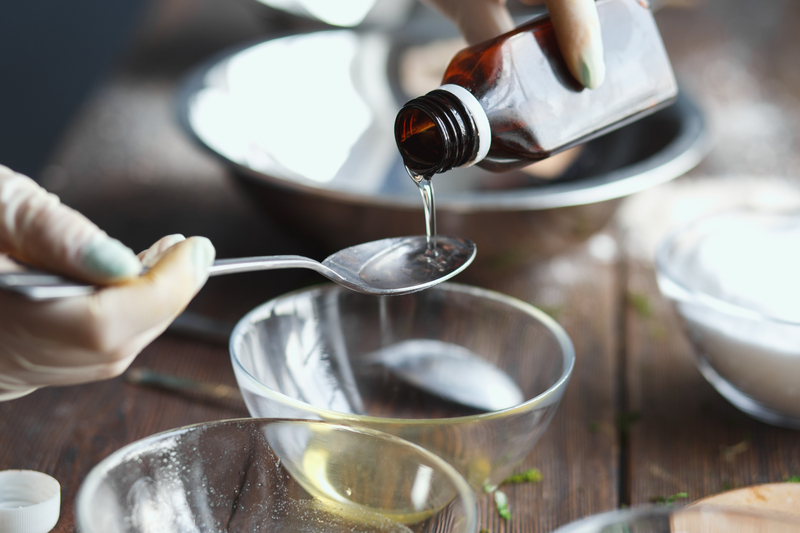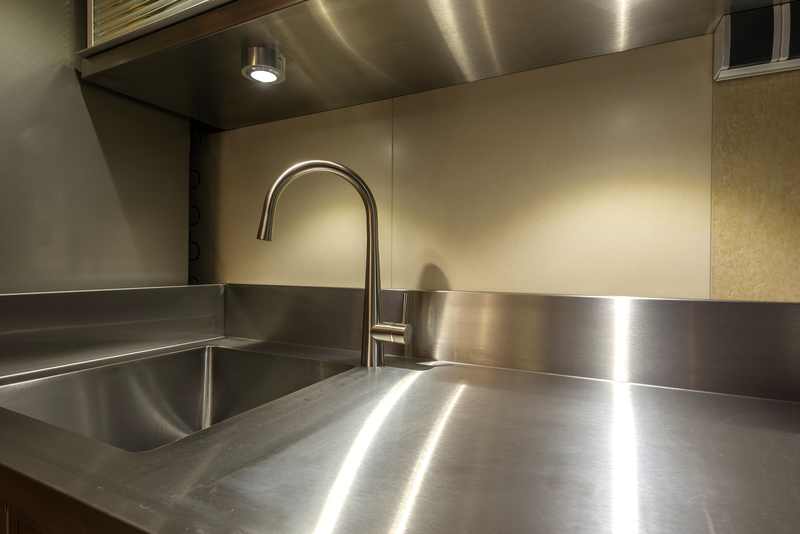Tips and Tricks for a Sparkling Clean Stovetop: No More Burnt-on Residue
Posted on 09/09/2025
Tips and Tricks for a Sparkling Clean Stovetop: No More Burnt-on Residue
If you've ever struggled with burnt-on residue and stubborn stains on your stovetop, you're certainly not alone. A clean and gleaming stovetop not only makes your kitchen look pristine but also ensures better hygiene and safety during meal preparation. In this guide, we'll reveal the best tips and tricks for a sparkling clean stovetop, helping you say goodbye to tough, greasy messes and hello to effortless cleaning.

Why Is Keeping Your Stovetop Clean Important?
Many homeowners underestimate the importance of a clean stovetop. Beyond aesthetics, a grime-free surface is essential for food safety, optimal appliance performance, and even energy efficiency. Heavy residue can trap bacteria, render burners ineffective, and create potential fire hazards. Regularly tackling that annoying caked-on residue is, therefore, a must for any functional kitchen.
The Challenges of Burnt-on Residue
No matter how cautious you are, sometimes spills and splatters will occur. When these aren't cleaned up quickly, they harden, resulting in those tough, burnt-on stains and residue that seem almost impossible to remove. Whether you have a gas, electric, or glass stovetop, each surface poses unique challenges for thorough cleaning.
Understanding Different Types of Stovetops
Before diving into the cleaning techniques, it's crucial to know which type of stovetop you own. Different materials demand unique cleaning methods. Here's a quick overview:
- Gas Stovetops: Feature removable grates and burners; prone to splatters and accumulation around burners.
- Electric Coil Stovetops: Consist of raised metal coils; spills can drip underneath and burn onto the drip pans.
- Glass or Ceramic Cooktops: Smooth surfaces that show burnt residue and streaks easily; can be scratched by abrasive tools.
Top Tips and Tricks for a Sparkling Clean Stovetop
1. Clean as You Go: Prevention is Better than Cure
One of the most effective ways to maintain a sparkling clean cooktop is to clean minor spills immediately. Don't wait for splatters to turn into stubborn residues. After cooking, allow the stovetop to cool slightly, then wipe away fresh spills using a damp cloth or sponge. This simple habit greatly reduces the risk of challenging burnt-on stains.
2. Use Baking Soda and Vinegar for Stubborn Residue
For common burnt-on residue on stovetops, baking soda combined with white vinegar is a tried-and-true cleaning duo:
- Sprinkle a generous amount of baking soda over the affected area.
- Spray or drip a small amount of white vinegar onto the soda. The mixture will fizz, loosening the residue.
- Let it sit for 15-20 minutes to break down grime.
- Scrub gently with a non-abrasive sponge, then wipe clean with a damp cloth.
This method works well for both gas and electric stovetops, as well as on glass cooktops. Note: Avoid using steel wool or highly abrasive pads on smooth glass surfaces to prevent scratching.
3. Leverage Commercial Cleaners for Tough Jobs
When natural solutions just aren't enough, it's okay to reach for a specialized cooktop cleaner. Products labeled "stovetop cleaner" or "range cleaner" are formulated to dissolve grease and burnt food residue effectively. Always follow the manufacturer's guidelines and test a small spot first, especially on ceramic or glass.
4. Deep Cleaning Removable Parts
Don't neglect the components you can take off! Grates, burner caps, and drip pans can be soaked in hot, soapy water for 20-30 minutes. For seriously stuck-on messes:
- Scrub with a paste made of baking soda and water.
- Use a soft brush or old toothbrush to dislodge residue from hard-to-reach spots.
- Allow all parts to dry thoroughly before reassembling to prevent rust and damage.
5. Don't Forget the Knobs and Controls
Grease and food splashes often accumulate around controls. Carefully remove stove knobs (refer to your stove's manual) and wash them with warm, soapy water. Wipe the surface beneath and around each knob, then replace them once completely dry.
6. The Magic of Razor Blades (For Glass Cooktops Only)
For flat glass or ceramic stovetops with persistent, burnt spots, use a razor blade scraper. Hold at a 45-degree angle, gently working across the residue. Be cautious not to gouge or scratch the glass! Always use blades specifically designed for cooktops and proceed carefully.
7. Create a Cleaning Schedule
Consistency is crucial. Below is a sample stovetop cleaning routine:
- After Each Use: Wipe any visible spills.
- Once a Week: Remove grates/burners and clean thoroughly; treat tough spots with baking soda/vinegar.
- Monthly: Deep clean all parts, including knobs and under the burners, for a sparkling result year-round.
Tailored Techniques for Different Stove Types
Gas Stovetops
Gas stoves are robust but often trap grease around burners.
- Remove grates and burner caps regularly.
- Use a degreaser on metal parts, followed by a thorough rinse.
- Avoid getting water in the ignite ports--use a brush for tight spots.
- Keep all parts completely dry to prevent rust.
Electric Coil Stovetops
Electric coils can be gently wiped with a damp sponge once unplugged and cooled. Drip pans beneath the coils are notorious for collecting burnt food. Soak these in hot, soapy water and scrub well. If stains persist, try a solution of bakingsoda and vinegar or a commercial cleaner.
Glass and Ceramic Cooktops
These sleek surfaces are stunning but prone to visible stains and scratches.
- Use only non-abrasive sponges.
- Apply specially formulated glass or ceramic stove cleaners.
- Wipe in circular motions; avoid harsh chemicals or rough tools.
- Buff dry with a microfiber cloth for streak-free shine.
Pro Tips for Sparkling Stovetops
- Use liners: Place spill-proof liners under burners or in drip pans to catch spills before they harden.
- Always let surfaces cool: Avoid cleaning a hot cooktop, as this can damage the surface or cause burns.
- Don't oversaturate: Excess moisture can seep into controls and cause electrical issues or rusting.
- Microfiber for the win: Use a microfiber cloth to polish and absorb streaks for a sparkling finish.
Frequently Asked Questions
How do I get rid of tough, burnt stains on my stovetop?
For persistent stains, apply a paste of baking soda and water, let sit, then scrub gently with a non-scratch sponge. For glass tops, use a razor blade scraper. Always avoid harsh abrasives to prevent damage.
Can I use bleach to clean my cooktop?
While bleach kills germs, it's generally too harsh for stovetops and may damage surfaces or discolor metal. Stick to gentle, effective methods like baking soda, vinegar, or a dedicated stovetop cleaner.
How often should I deep clean my stovetop?
For optimal results, deep clean monthly. Light, quick wipes after each use prevent the build-up of burnt-on residue and keep your stovetop sparkling clean every day.
What should I never use on a glass cooktop?
Steer clear of steel wool, abrasive powders, or harsh chemicals. These can scratch, pit, or cloud the glass, ruining its sleek look.
Maintenance and Long-Term Care
Proper care and maintenance are vital for the longevity of your stovetop. Remember to:
- Routinely check your burners, grates, and drip pans for signs of wear or corrosion.
- Replace damaged components to keep cooking safe and efficient.
- Wipe the stovetop after every use to prevent stains from setting in.
- Schedule regular deep cleans to remove hard-to-see grease and food bits.

Eco-Friendly and DIY Cleaning Alternatives
Prefer natural cleaning solutions? Try these safe and eco-friendly options:
- Lemon Juice: The citric acid in lemon not only cuts through grease but also leaves behind a pleasant, fresh aroma.
- Baking Soda and Water Paste: Gently abrasive and non-toxic, this paste can clean most tough spots without harming your cooktop.
- White Vinegar: Acts as a degreaser and sanitizer. Mix with water in a spray bottle for an easy, daily cleaning spritz.
Conclusion: Make Stovetop Cleaning Effortless
Regular, consistent care coupled with smart cleaning hacks is the secret to a sparkling clean stovetop. By adopting these tips and tricks for removing burnt-on residue and embracing simple preventive habits, you'll keep your kitchen gleaming and inviting all year long.
Remember: The key is quick action, gentle products, and regular deep cleans. No more dreading tough grime--enjoy cooking on a spotless, hygienic stove with these comprehensive stovetop cleaning strategies!
```



